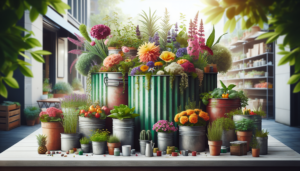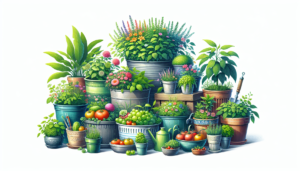Container gardening is a fantastic way to bring the beauty of nature into your own space, even if you have limited room to work with. Whether you have a small balcony, a sunny window sill, or just a tiny patch of a garden, container gardening allows you to create a lush and vibrant oasis. In this informative article, we will explore the world of container gardening and present you with a comprehensive guide to RHS recommended plants. Get ready to transform your space into a blooming paradise!
Choosing the Right Containers
Size of the container
When choosing containers for your garden, it’s important to consider the size of the container. The size of the container will depend on the type of plants you want to grow and the space you have available. Larger plants, such as fruit trees or shrubs, will require bigger containers to accommodate their root systems. On the other hand, smaller plants like herbs or flowers can thrive in smaller containers. Remember to choose a size that allows enough room for the roots to grow and provides adequate space for the plant to reach its full potential.
Material of the container
Another important factor to consider is the material of the container. There are a variety of materials to choose from, including plastic, terracotta, ceramic, or even recycled materials. Plastic containers are lightweight and easy to move around, while terracotta and ceramic containers provide better insulation and a more aesthetically pleasing look. Consider the climate in your area and the specific needs of your plants when selecting the material for your containers.
Drainage holes
Proper drainage is crucial for the health of your plants in container gardening. Make sure to choose containers with drainage holes to allow excess water to escape, preventing root rot and other water-related issues. If you come across a container without drainage holes but you love its design, consider drilling holes in the bottom to ensure proper drainage. Remember to place a saucer underneath to catch excess water and prevent it from pooling on the surface where your containers are placed.
Choosing a suitable color and style
Container gardening allows for endless creativity, so choosing containers in suitable colors and styles can enhance the overall aesthetics of your garden. Consider the color of your plants and choose containers that complement or provide contrast, depending on the look you want to achieve. Additionally, think about the overall style or theme of your garden and select containers that align with that vision. This can range from sleek and modern to rustic and vintage-inspired containers.
Consider weight and portability
Container gardening offers the advantage of mobility, allowing you to move your plants around as needed. However, it’s essential to consider the weight and portability of the containers you choose. If you plan to move your plants frequently or have limited physical strength, opt for lightweight containers made of materials like plastic or resin. On the other hand, if you prefer sturdier containers, consider getting a plant caddy or stand with wheels to make moving them easier.
Using recycled containers
Consider opting for recycled containers for your container gardening. Not only is this an environmentally friendly choice, but it can also add a unique and eclectic touch to your garden. Look for old buckets, wooden crates, or even repurpose items like old tea tins or wine barrels. Just ensure that the containers are thoroughly cleaned and have proper drainage before planting in them. By using recycled containers, you can reduce waste and give new life to items that would otherwise end up in a landfill.
Choosing self-watering containers
For those who prefer low-maintenance gardening, self-watering containers can be a great option. These containers are designed with a built-in reservoir that holds water, allowing the plants to draw water as needed. This can be especially useful if you have a busy schedule or tend to forget to water your plants regularly. Self-watering containers not only help prevent overwatering but also ensure that your plants receive a consistent water supply, promoting healthy growth.
Vertical gardening containers
If you have limited space or want to create a unique garden display, consider vertical gardening containers. These containers are specifically designed to be mounted vertically, allowing you to utilize vertical wall space or create hanging gardens. Vertical gardening containers are available in various shapes and sizes, including wall-mounted planters, hanging baskets, and pocket planters. This innovative approach to container gardening maximizes space and adds a visually appealing element to your garden.
Container placement and positioning
Where you place your containers is vital to the success of your container gardening. Consider the sunlight requirements of your plants and choose a location that provides the appropriate amount of light. Most plants require at least six hours of sunlight daily, so choose a spot that receives adequate sun exposure. Additionally, ensure that the containers are placed on a stable surface and are not at risk of being knocked over by strong winds or heavy rain. Take into account the potential growth of your plants and leave enough space for them to expand without becoming overcrowded.
Container maintenance
Maintaining your containers is essential for the ongoing health and growth of your plants. Regular maintenance tasks include watering, fertilizing, pruning, and ensuring overall cleanliness. Monitor the moisture level of the soil in your containers and adjust the watering accordingly, ensuring that the soil is neither too dry nor too soggy. Regularly check for pests and diseases, and take appropriate action if necessary. Additionally, trim back any dead or overgrown foliage and fertilize your plants as needed to promote healthy growth. By staying on top of container maintenance, you can enjoy a thriving and beautiful garden throughout the growing season.
Soil and Potting Mix
Importance of choosing the right soil
The type of soil you use in your containers can significantly impact the growth and health of your plants. Choosing the right soil is crucial as it provides support, nutrients, and proper drainage for the plants. Good-quality soil should be rich in organic matter, well-draining, and provide essential nutrients.
Understanding RHS recommended potting mix
The Royal Horticultural Society (RHS) provides guidelines and recommendations for potting mix compositions based on extensive research and expertise. Using a potting mix that adheres to RHS recommendations ensures that your plants receive the appropriate balance of nutrients, water holding capacity, and aeration.
Creating a well-draining mix
A well-draining potting mix is essential to prevent waterlogged soil and root rot in container gardening. To create a well-draining mix, combine equal parts of peat moss or coconut coir, vermiculite, and perlite. These ingredients promote good drainage while retaining enough moisture for the plants to thrive.
Soil amendments and nutrients
In addition to a well-draining mix, incorporating soil amendments and nutrients can further enhance the quality of your soil. Organic matter such as compost, well-rotted manure, or worm castings can improve soil fertility and structure. Additionally, adding slow-release organic fertilizers or balanced granular fertilizers can provide the necessary nutrients for plant growth.
Sterilization and disease prevention
Sterilizing your potting mix is important for disease prevention, especially when reusing soil or using homemade compost. Sterilization can be achieved by heating the soil in an oven or microwave to kill any pathogens or weed seeds. This ensures that your plants are not exposed to harmful diseases and pests.
Choosing sustainable soil options
In line with sustainable gardening practices, consider choosing soil options that have a low environmental impact. Look for products that use sustainable sourcing and manufacturing processes. Additionally, seek out soil mixes that are peat-free, as peat extraction can deplete natural reserves and contribute to carbon emissions.
Choosing organic options
Organic potting mixes are a popular choice for container gardening enthusiasts who prioritize natural and chemical-free options. Organic mixes contain only natural ingredients and are free from synthetic fertilizers or pesticides. This aligns with organic gardening principles and helps create a healthier and more sustainable growing environment.
Watering requirements for different plant types
Different plants have varying watering requirements, and understanding these needs is crucial for successful container gardening. Research the water needs of the specific plants you are growing and adjust your watering routine accordingly. Some plants prefer drier conditions, while others require more frequent watering. By providing the right amount of water, you can avoid issues such as root rot or drought stress.
Mulching and soil protection
Applying mulch to the top layer of your container soil helps conserve moisture, suppress weed growth, and protect the soil from extreme temperatures. Organic mulches, such as straw, wood chips, or compost, are ideal for containers as they break down over time and add nutrients to the soil. Apply a layer of mulch around your plants, leaving a small gap around the base of the plant to prevent moisture buildup and potential rot.
Dealing with common soil problems
Container gardening can present unique challenges when it comes to soil health. Common soil problems in containers include compacted soil, nutrient deficiencies, or pH imbalances. Regularly monitoring the soil and taking appropriate action, such as aerating the soil, fertilizing, or adjusting the pH, can help alleviate these issues. If problems persist, consider repotting your plants with fresh soil to provide them with a healthier growing environment.







